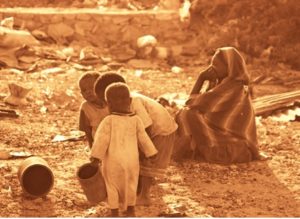Deero Ismail, a mother of five, fled her home town of Baidoa in southern Somalia in February, 2011 after her husband was killed by the militant group which controlled the town.

With her children, she lives in a hut, made of dried tree branches and covered with plastic sheeting, in the Rajo camp for internally displaced people west of Mogadishu.
Established in early 2011, at about the time that Ismail sought shelter, Rajo camp is now the largest settlement for the internally displaced in the area around Somalia’s capital.
Rajo — which means “hope” — is the home of 5,000 families mostly from southern parts of the country, which was hit by drought in 2011.
A quarter of a million people died during the ensuing famine, the first in the Horn of Africa region for more than three decades.
Drought isn’t the only problem. The UN Office for Humanitarian Co-ordination estimates that more than 1.1m people are internally displaced in Somalia as a result of two and a half decades of conflict, as well as droughts that have affected up to a third of the country’s population.
Ismail is struggling to survive. Assistance in the form of aid from the UN World Food Programme and Turkish nongovernmental organisations has dwindled.
“We had a farm and cows. [Before his death] my husband was our breadwinner,” she says. “First the drought was severe and we lost our cows. Then there wasn’t rain to grow the farm so life became harder to us, so I fled with my kids to Mogadishu.”
The food aid which used to be distributed monthly is now sporadic and humanitarian organisations have struggled with funding.
Even when food aid was more regular, Ismail speaks about a “gatekeeper”, a man who would give her food only if he was rewarded with a portion of it. “It is like tax on access to aid,” she says.
Like many other women in the camps, she earns less than a dollar a day by cleaning homes and washing clothes for families in nearby neighbourhoods. This small income, she says, helps her provide at least one meal a day to her five children. “It is not enough,” she adds.
Abdi Kuusow, a father of seven living in the Badbaado camp in Mogadishu, was forced to flee his home because of violence.
“I came from Marka town in Lower Shebelle region in 2012 due to the fighting there,” he says. “We first fled to Afgoye town about 30km from Mogadishu and another fight broke out there which forced me and my family to flee to Badbaado camp.”
Kuusow recalls the conditions in the camp when he first arrived.
“Every day we had to dig a grave for a dead child. Sometimes we had to bury two dead children at once because of the severe malnutrition the kids faced. I have also lost my son, who was one year old, who became sick due to malnutrition.”
Unicef data shows that Somalia has the highest levels of malnutrition in the world, with more than 300,000 children affected.
Kuusow says his camp gets no aid, adding that many of the residents were forced to leave because of pressure from politically connected people who claimed the land for themselves. He says he has nowhere to go.
“The land grabbers ordered us to vacate the camp. One day they came with armed men and told us to move and beat me, but where do I go? Nowhere. I cannot afford to rent a house, I told them. Some of my neighbours fled, fearing to be killed or arrested. But I stayed,” he says.
Read more: Somali camps: Places of desperation
Source: Financial Mail


